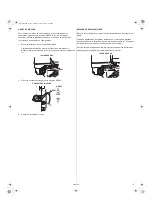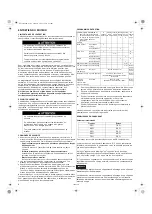
ENGLISH
3
SETTING
Fuel System
This engine uses LPG.
You must prepare an LPG cylinder, low pressure regulator, LPG
hose, and two hose clamps because these are not included with
this engine. Be sure to use parts that are for LPG use.
Also, these are not covered under Honda warranty, so you must
perform engine connections and maintenance.
• Use an LPG-compliant LPG
hose with an inner diameter of
10 mm.
• Use a LPG hose with a length
of 5 m or shorter between the
low pressure regulator and engine.
• When handling the LPG hose, keep it away from hot parts and
edges.
• Use a low pressure regulator that satisfies the following standard
and performance specifications.
* The excess flow valve may be described as a "safety system"
in the Regulator catalog, etc.
• Use an LPG hose and hose clamps that are suited for LPG
purposes.
• Attach the LPG hose to the low pressure regulator of the LPG
cylinder and the LPG hose joint on the engine.
• When attaching the LPG hose, be sure to use clips to fasten the
LPG hose.
• Keep the engine and LPG cylinder as far apart as possible.
• Use the LPG cylinder while it is standing upright.
• After connecting the engine and LPG cylinder with the LPG hose,
apply soapy water and check that there are no gas leaks.
Standard
Based on EN 16129
Gas flow rate
1.2 kg/h or higher (GX200)
3.4 kg/h or higher (GX390)
Excess flow valve
*
none
LOW PRESSURE
REGULATOR
LPG CYLINDER
LPG HOSE
HOSE CLAMP
HOSE CLAMP
10mm
LPG HOSE
LPG HOSE JOINT
LPG HOSE
HOSE
CLAMP
HOSE
CLAMP
LPG CYLINDER
LPG HOSE JOINT
LOW PRESSURE REGULATOR
LPG
HOSE
HOSE CLAMP
HOSE
CLAMP
LPG HOSE
LOW PRESSURE
REGULATOR
BEFORE OPERATION CHECKS
IS YOUR ENGINE READY TO GO?
For your safety, and to maximize the service life of your equipment,
it is very important to take a few moments before you operate the
engine to check its condition. Be sure to take care of any problem
you find, or have your servicing dealer correct it, before you
operate the engine.
Before beginning your pre-operation checks, be sure the engine is
level and the engine switch is in the OFF position.
Always check the following items before you start the engine:
Fuel Gas Connection
You must connect the LPG hose to this engine.
Fuel Gas Leak and LPG Hose Damage Check
Coat the LPG hose joint with soapsuds and check that there is no
fuel gas leaks.
Check that the LPG hose is not damaged.
If the LPG hose is damaged or there is a gas leak, discontinue use.
Take measures to fix the connection or replace the parts, and check
that there are no gas leaks before starting the engine.
Check the General Condition of the Engine
Before each use, look around and underneath the engine for signs
of oil leaks.
1. Remove any excessive dirt or debris, especially around the
muffler and recoil starter.
2. Look for signs of damage.
3. Check that all shields and covers are in place, and all nuts,
bolts, and screws are tightened.
Check the Engine
Before each use, look around and underneath the engine for signs
of oil leaks.
1. Check the engine oil level (see page 7). Running the engine with
a low oil level can cause engine damage.
The Oil Alert system (applicable types) will automatically stop
the engine before the oil level falls below safe limits. However,
to avoid the inconvenience of an unexpected shutdown, always
check the engine oil level before startup.
2. Check the air filter element (see page 8). A dirty air filter
element will restrict air flow to the mixer, reducing engine
performance.
3. Check the equipment powered by this engine.
Review the instructions provided with the equipment powered
by this engine for any precautions and procedures that should
be followed before engine startup.
Failure to properly maintain this engine, or failing to
correct a problem before operation, could result in a
significant malfunction.
Some malfunctions can cause serious injuries or
death.
Always perform a pre-operation inspection before
each operation and correct any problems.
3RZ1C8000.fm Page 3 Friday, April 13, 2018 9:19 AM




































